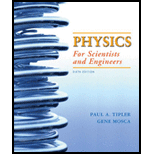
Concept explainers
To calculate:
The coefficient of the reflection and transmission at the point of the junction.
Answer to Problem 68P
The coefficient of the reflection and transmission at the point of the junction is
Explanation of Solution
Given:
Length of the string:
Mass of the string:
Length of the twine:
Mass of the twine:
Formula used:
The coefficient of the reflection is given as:
The coefficient of the transmission is given as:
Calculation:
The speed of the pulse on the string is calculated as:
The speed of the pulse on the twine is calculated as:
Divide the equation (2) by equation (1) as:
Now, the coefficient of the reflection is calculated as:
Now put the values of
Put all the given values in above equation.:
The coefficient of the transmission is given as:
Divide the numerator and denominator of the above eq. by
Now the put the value of the ratio of
Now put the values of
Conclusion:
Hence, the coefficient of the reflection and transmission at the point of the junction is
Want to see more full solutions like this?
Chapter 15 Solutions
Physics for Scientists and Engineers
- Consider two sinusoidal waves traveling along a string, modeled as y1(x,t)=0.3msin(4m1x+3s1t) and y2(x,t)=0.6msin(8m1x6s1t) . What is the height of the resultant wave formed by the interference of the two waves at the position x=0.5 m at time t=0.2 s?arrow_forwardTwo sinusoidal waves are moving through a medium in the positive x-direction, both having amplitudes of 7.00 cm, a wave number of k=3.00 m-1, an angular frequency of =2.50 s-1, and a period of 6.00 s, but one has a phase shift of an angle =12 rad. What is the height of the resultant wave at a time t=2.00 s and a position x=0.53 m?arrow_forwardThe speed of a transverse wave on a string is 300.00 m/s, its wavelength is 0.50 m, and the amplitude is 20.00 cm. How much time is required for a particle on the string to move through a distance of 5.00 km?arrow_forward
- Two sinusoidal waves are moving through a medium in the positive x-direction, both having amplitudes of 6.00 cm, a wavelength of 4.3 m, and a period of 6.00 s, but one has a phase shift of an angle =0.50 rad. What is the height of the resultant wave at a time t=3.15 s and a position x=0.45 m ?arrow_forwardConsider two sinusoidal sine waves traveling along a string, modeled as y1(x,t)=0.3msin(4m1x3s1t) and y2(x,t)=0.3msin(4m1x+3s1t) . What is the wave function of the resulting wave? [Hint: Use the trig identity sin(uv)=sinucosvcosusinvarrow_forwardA string with a mass of 0.30 kg has a length of 4.00 m. If the tension in the string is 50.00 N, and a sinusoidal wave with an amplitude of 2.00 cm is induced on the string, what must the frequency be for an average power of 100.00 W?arrow_forward
- Two sinusoidal waves are moving through a medium in the same direction, both having amplitudes of 3.00 cm, a wavelength of 5.20 m, and a period of 6.52 s, but one has a phase shift of an angle . What is the phase shift if the resultant wave has an amplitude of 5.00 cm? [Hint: Use the trig identity sinu+sinv=2sin(u+v2)cos(uv2)arrow_forwardA string is fixed at both end. The mass of the string is 0.0090 kg and the length is 3.00 m. The string is under a tension of 200.00 N. The string is driven by a variable frequency source to produce standing waves on the string. Find the wavelengths and frequency of the first four modes of standing waves.arrow_forwardAt t = 0, a transverse pulse in a wire is described by the function y=6.00x2+3.00 where xand y are in meters. If the pulse is traveling in the positive x direction with a speed of 4.50 m/s, write the function y(x, t) that describes this pulse.arrow_forward
- Transverse waves travel through a string where the tension equals 7.00 N with a speed of 20.00 m/s. What tension would be required for a wave speed of 25.00 m/s?arrow_forwardBy what factor would von have to multiply the tension in a stretched string so as to double the wave speed? Assume the siring does not stretch. (a) a factor of 8 (b) a factor of 4 (c) a factor of 2 (d) a factor of 0.5 (e) Yon could not change the speed by a predictable factor by changing the tension.arrow_forwardA nylon guitar string is fixed between two lab posts 2.00 m apart. The string has a linear mass density of =7.20 g/m and is placed under a tension of 160.00 N. The string is placed next to a tube, open at both ends, of length L. The string is plucked and the tube resonates at the n=3 mode. The speed of sound is 343 m/s. What is the length of the tube?arrow_forward
 Principles of Physics: A Calculus-Based TextPhysicsISBN:9781133104261Author:Raymond A. Serway, John W. JewettPublisher:Cengage Learning
Principles of Physics: A Calculus-Based TextPhysicsISBN:9781133104261Author:Raymond A. Serway, John W. JewettPublisher:Cengage Learning Physics for Scientists and Engineers, Technology ...PhysicsISBN:9781305116399Author:Raymond A. Serway, John W. JewettPublisher:Cengage Learning
Physics for Scientists and Engineers, Technology ...PhysicsISBN:9781305116399Author:Raymond A. Serway, John W. JewettPublisher:Cengage Learning University Physics Volume 1PhysicsISBN:9781938168277Author:William Moebs, Samuel J. Ling, Jeff SannyPublisher:OpenStax - Rice University
University Physics Volume 1PhysicsISBN:9781938168277Author:William Moebs, Samuel J. Ling, Jeff SannyPublisher:OpenStax - Rice University Classical Dynamics of Particles and SystemsPhysicsISBN:9780534408961Author:Stephen T. Thornton, Jerry B. MarionPublisher:Cengage Learning
Classical Dynamics of Particles and SystemsPhysicsISBN:9780534408961Author:Stephen T. Thornton, Jerry B. MarionPublisher:Cengage Learning Physics for Scientists and Engineers: Foundations...PhysicsISBN:9781133939146Author:Katz, Debora M.Publisher:Cengage Learning
Physics for Scientists and Engineers: Foundations...PhysicsISBN:9781133939146Author:Katz, Debora M.Publisher:Cengage Learning




